
|
You entered: Jupiter
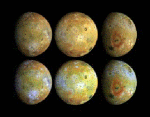 Three Views of Jupiter's Io
Three Views of Jupiter's Io
3.10.1996
The Galileo spacecraft orbiting Jupiter continues to return impressive results. The Galileo team has just released three more photographs of Jupiter's volcanic moon Io taken in June. These three photos are reflected at the bottom of the above picture, digitally enhanced to better show important features.
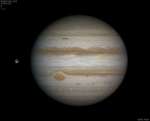 Jupiter, Ganymede, Great Red Spot
Jupiter, Ganymede, Great Red Spot
15.05.2015
In this sharp snapshot, the Solar System's largest moon Ganymede poses next to Jupiter, the largest planet. Captured on March 10 with a small telescope from our fair planet Earth, the scene also includes Jupiter's Great Red Spot, the Solar System's largest storm.
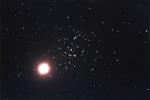 Jupiter in the Hive
Jupiter in the Hive
3.04.2003
If you can find planet Jupiter in tonight's sky, then you can also find M44, popularly known as the Beehive star cluster. In fact, with a pair of binoculars most casual skygazers should find it easy to zero in on this celestial scene.
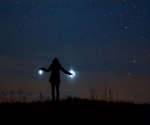 Jupiter and Venus from Earth
Jupiter and Venus from Earth
18.03.2012
It was visible around the world. The sunset conjunction of Jupiter and Venus was visible last week almost no matter where you lived on Earth. Anyone on the planet with a clear western horizon at sunset could see them. This week the two are still notable, even though Jupiter has sunk below the brighter Venus.
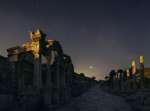 Jupiter over Ephesus
Jupiter over Ephesus
18.07.2008
A brilliant Jupiter shares the sky with the Full Moon tonight. Since Jupiter is near opposition, literally opposite the Sun in planet Earth's sky, Jupiter will rise near sunset just like the Full Moon.
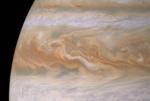 Jupiter Portrait
Jupiter Portrait
14.11.2003
Every day is a cloudy day on Jupiter, the Solar System's reigning gas giant. And swirling cloud tops are all you see in this stunningly detailed true color image, a portion of a large digital mosaic portrait of Jupiter recorded from the Cassini spacecraft during its Jovian flyby in December 2000.
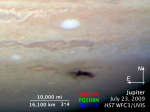 Hubble View: Jupiter Impact
Hubble View: Jupiter Impact
31.07.2009
This sprawling dark marking is Jupiter's latest impact scar, a debris plume created as a small asteroid or comet disintegrated after plunging into the gas giant's atmosphere. Located in Jupiter's south polar region, the new feature was discovered by Australian amateur astronomer Anthony Wesley on July 19.
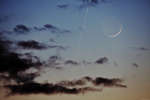 Jupiter and the Moons of Earth
Jupiter and the Moons of Earth
27.04.2012
Planet Earth has many moons. Its largest artifical moon, the International Space Station, streaks through this lovely skyview with clouds in silhouette against the fading light of a sunset. Captured from Stuttgart, Germany last Sunday, the frame also includes Earth's largest natural satellite 1.5 days after its New Moon phase.
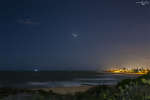 APOD: 2023 March 5 Б Jupiter and Venus over Italy
APOD: 2023 March 5 Б Jupiter and Venus over Italy
5.03.2023
What are those two bright spots? Planets. A few days ago, the two brightest planets in the night sky passed within a single degree of each other in what is termed a conjunction. Visible just after sunset in much of the world, the two bright spots were Jupiter (left) and Venus (right).
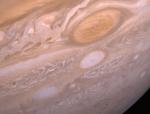 Giant Storm Systems Battle on Jupiter
Giant Storm Systems Battle on Jupiter
5.02.2002
Two of the largest storm systems on Jupiter are colliding, and nobody is sure what will result. The larger storm is the famous Great Red Spot, while the smaller is a large white oval. Both are swirling cloud systems that circulate on Jupiter.
|
January February March April May June July |
|||||||||||||||||||||||||||||||||||||||||||||||||